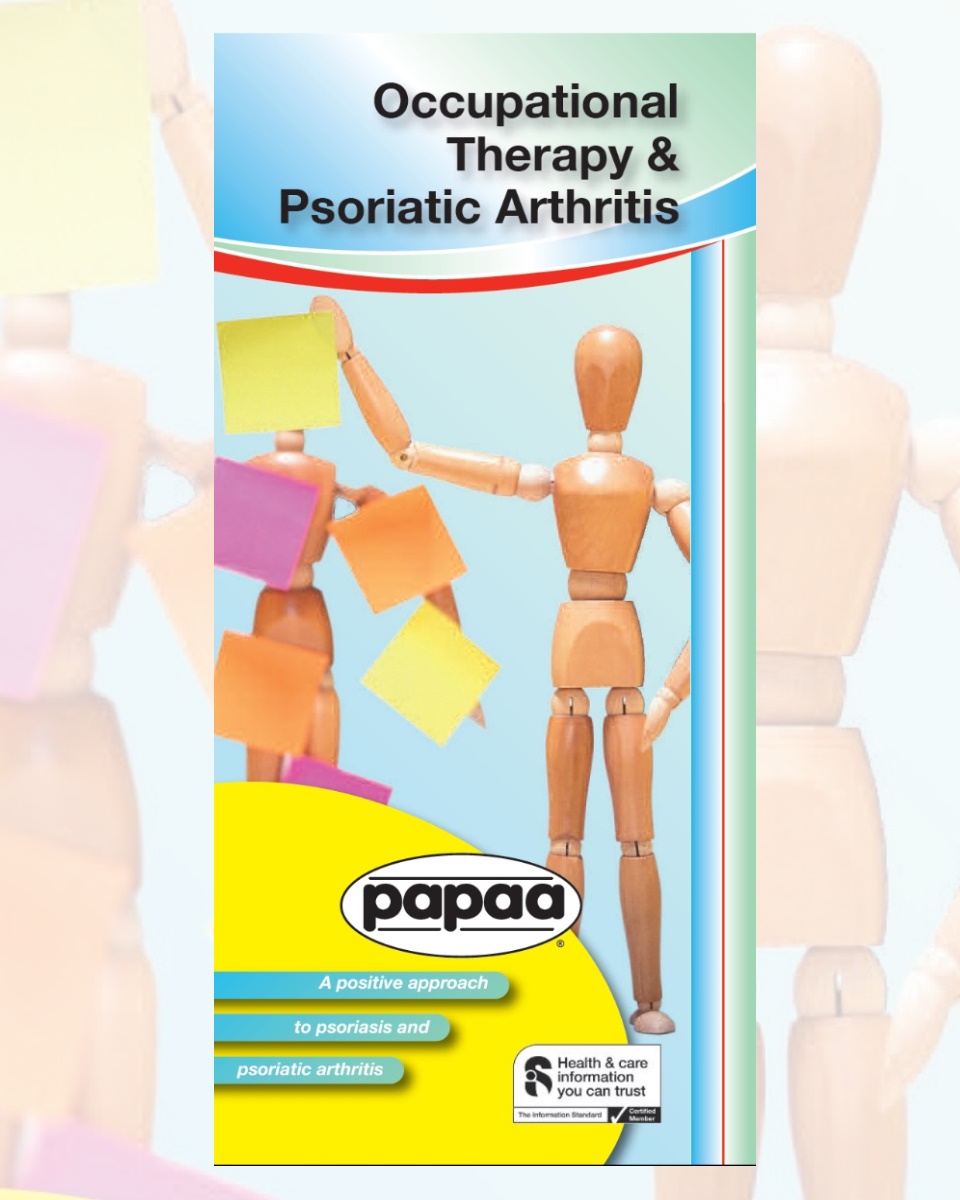
Search
You have no items in your basket

“Occupational therapy is a client-centred health profession concerned with promoting health and wellbeing through occupation. The primary goal of occupational therapy is to enable people to participate in everyday life.”
World Federation of occupational therapists, 2010
Occupational therapy enables people to manage, to the best of their ability, all types of daily living skills which may have been affected by physical or mental illness. Occupational therapists may be employed in hospitals, social services departments, community rehabilitation teams and many other settings.
When you have psoriatic arthritis, pain, stiffness and fatigue may make it more difficult to perform everyday activities such as dressing, making meals, driving, sleep, household chores, work, socialising and hobbies. An occupational therapist will work with you to help you find ways to overcome these difficulties. They will assess your physical restrictions, as well as listen to how you are coping with them emotionally, and together you will agree a treatment plan. You can expect to receive guidance on:
Occupational therapists can teach you joint protection techniques; some departments offer this via individual sessions and sometimes as a joint protection group programme, which has the benefit that you meet others with a similar condition. In this next section you’ll discover how to apply joint protection principles to everyday tasks:
Some activities require you to maintain a single position and so restrict joint movement for long periods of time (eg sewing, driving, reading and even sitting in front of a computer screen). These activities tire your muscles and tired muscles are less able to support your joints, which may lead to pain and damage.
Learn to take a break or change position you get too stiff and before pain increases. During breaks, move or rest your joints. Avoid standing or sitting for long periods of time. Use a timer to remind yourself to change position regularly. If you use a computer for long periods, you can download software which will provide alerts on your screen at set intervals.
Some people with PsA experience problems with the joints in their hands. A tight grip puts a lot of strain on knuckles and thumb joints and may increase your pain. You’ll tend to use a tight grip when you do things like writing, knitting, using a screwdriver and holding cutlery, a key or a toothbrush.
Joints work best in certain positions. When they are used in the wrong position, such as when twisting, extra force is placed through the joint and the muscles are unable to work as well as they should, which may result in pain and, over time, deformity. Avoid actions which push your joints into unnatural positions.
Stronger, larger joints can manage greater forces than smaller, weaker joints.
Use correct lifting and handling techniques
If pain continues for more than an hour after an activity has stopped, this means that the activity was too much and should have been changed or stopped sooner. Learn to pace yourself by taking short breaks or changing position before you get too stiff and before pain increases.
While too much activity can place excess stress on joints, a lack of movement can cause joints and muscles to stiffen. Exercise is an important part of strengthening the muscles around the joint and maintaining bone strength. Exercise can also assist in maintaining an ideal body weight, which is Important as excess weight may add extra stress to joints. It is important to talk to a healthcare professional about an appropriate exercise routine tailored to your individual capabilities. Your occupational therapist (or physiotherapist) can provide exercises to maintain range of movement and strength. See Physiotherapy and Exercise: Psoriatic Arthritis.
Not only is it important to keep your own weight down to reduce stress on your joints, it is also important to reduce the weight of the things you need to carry.
If you struggle when getting up from your bed, chair or toilet, you have several options available. When you next replace your furniture, consider having slightly higher items, as this may make it easier and cause less strain on your knees and wrists. However, ensure that they are not so high that your feet are dangling. You should be able to place your feet flat on the floor when you are sitting on them. You could also ask to be referred to a physiotherapist, for leg-strengthening exercises which will make it easier to get up after sitting or lying down. Your table and chair should be at a comfortable height when working. An occupational therapist can provide further information about the ergonomics of workstations.
If you find a particular activity painful, certain equipment can make a task easier by protecting joints and reducing the stress placed on smaller and weaker body parts. Occupational therapists can provide information and more specific advice on equipment and techniques which may assist in performing everyday tasks.
Your occupational therapist may suggest the use of splints, such as wrist or thumb splints, during activities which are painful. However, these should only be used during particular tasks to provide support to painful joints, rather than being worn constantly, as this may affect your strength over time. Splints can also be recommended for night-time if you have difficulty sleeping due to hand/wrist pain. They should be used in conjunction with a prescribed exercise programme. It is important to discuss your needs with a trained healthcare professional before you use splints.
It may be that your condition makes it difficult to do your current job or to find suitable employment. If you have a longterm condition (12 months or more) which has a substantial effect on your ability to carry out normal day-to-day activities, then you may be entitled to certain help under the Equality Act 2010. An occupational therapist can advise you on what help is available and may provide advice to help you feel more confident when discussing “reasonable adjustments” with Your employer. They can also look at the activities you carry out at work and suggest ways of performing them which may reduce the strain on your body. If you have a deskbased job and use a computer, consider downloading free software to remind you to take breaks. If you are not working, an occupational therapist may also advise you on studying or retraining options. The disability employment advisor at your local job centre can advise you about programmes and support to get you back into work.
It is important that you keep active but do not try to push through pain. Your occupational therapist can help you look at how you plan and structure your time so that you avoid either long periods of rest, repetitive movements or excessive activity. A regular eating and sleeping pattern is very important and you should try to avoid prolonged exposure to stress.
Relaxation is a key skill in managing long-term pain. Many occupational therapists spend time on fatigue and sleep management, particularly in specialist rheumatology services. In some settings, occupational therapists are able to teach this skill and advise you on how to incorporate relaxation techniques into daily life.
Occupational therapy is about doing the tasks that you want to do, but maybe in a slightly different way. An occupational therapist can help you find ways of protecting your joints and avoiding pain, show you how to manage your condition and become your own expert, and advise you on equipment and general lifestyle changes.

This article is adapted from the Occupational therapy and psoriatic arthritis leaflet.
Download our Occupational therapy and psoriatic arthritis leaflet as a pdf
Always consult your doctor or healthcare provider